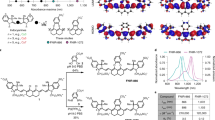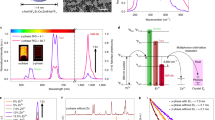Abstract
We report here the in vivo diagnostic use of a peptide–dye conjugate consisting of a cyanine dye and the somatostatin analog octreotate as a contrast agent for optical tumor imaging. When used in whole-body in vivo imaging of mouse xenografts, indotricarbocyanine-octreotate accumulated in tumor tissue. Tumor fluorescence rapidly increased and was more than threefold higher than that of normal tissue from 3 to 24 h after application. The targeting conjugate was also specifically internalized by primary human neuroendocrine tumor cells. This imaging approach, combining the specificity of ligand/receptor interaction with near-infrared fluorescence detection, may be applied in various other fields of cancer diagnosis.
This is a preview of subscription content, access via your institution
Access options
Subscribe to this journal
Receive 12 print issues and online access
$209.00 per year
only $17.42 per issue
Buy this article
- Purchase on Springer Link
- Instant access to full article PDF
Prices may be subject to local taxes which are calculated during checkout






Similar content being viewed by others
References
Axelrad, A.M. et al. High-resolution chromoendoscopy for the diagnosis of diminutive colon polyps: implications for colon cancer screening. Gastroenterology 110, 1253–1258 (1996).
Acosta, M.M. & Boyce, H.W. Jr. Chromoendoscopy: where is it useful? J. Clin. Gastroenterol. 27, 13–20 (1998).
Fleischer, D.E. Chromoendoscopy and magnification endoscopy in the colon. Gastrointest. Endosc. 49, S45–S49 (1999).
Wang, T.D. et al. Fluorescence endoscopic imaging of human colonic adenomas. Gastroenterology 111, 1182–1191 (1996).
Stepp, H., Sroka, R. & Baumgartner, R. Fluorescence endoscopy of gastrointestinal diseases: basic principles, techniques and clinical experience. Endoscopy 30, 379–386 (1998).
Marcon, N.E. & Wilson, B.C. The value of fluorescence techniques in gastrointestinal endoscopy: better than the endoscopist's eye? I: The North American experience. Endoscopy 30, 419–421 (1998).
Haringsma, J. & Tytgat, G.N. The value of fluorescence techniques in gastrointestinal endoscopy: better than the endoscopist's eye? I: The European experience. Endoscopy 30, 416–418 (1998).
Brand, S. et al. Detection of colonic dysplasia by light-induced fluorescence endoscopy: a pilot study. Int. J. Colorectal Dis. 14, 63–68 (1999).
Folli et al. Antibody–indocyanin conjugates for immunophotodetection of human squamous cell carcinoma in nude mice. Cancer Res. 54, 2643–2649 (1994).
Ballou, B. et al. Tumor labeling in vivo using cyanine-conjugated monoclonal antibodies. Cancer Immunol. Immunother. 41, 257–263 (1995).
Licha, K. et al. Hydrophilic cyanine dyes as contrast agents for near-infrared tumor imaging: synthesis, photophysical properties and spectroscopic in vivo characterization. Photochem. Photobiol. 72, 392–398 (2000).
Becker, A. et al. Macromolecular contrast agents for optical imaging of tumors: comparison of indotricarbocyanine-labeled human serum albumin and transferrin. Photochem. Photobiol. 72, 234–241 (2000).
Neri, D. et al. Targeting by affinity-matured recombinant antibody fragments of an angiogenesis-associated fibronectin isoform. Nat. Biotechnol. 15, 1271–1275 (1997).
Weissleder, R., Tung, C.-H., Mahmood, U. & Bogdanov, A. Jr. In vivo imaging of tumors with protease-activated near-infrared fluorescent probes. Nat. Biotechnol. 17, 375–378 (1999).
Goldsmith, S.J. Receptor imaging: competitive or complementary to antibody imaging? Semin. Nucl. Med. 27, 85–93 (1997).
Reubi, J.C. Relevance of somatostatin receptors and other peptide receptors in pathology. Endocr. Pathol. 8, 11–20 (1997).
Ehlers, R.A. et al. Gut peptide receptor expression in human pancreatic cancers. Ann. Surg. 231, 838–848 (2000).
Reubi, J.C., Lang, W., Maurer, R., Koper, J.W. & Lamberts, S.W.J. Distribution and biochemical characterization of somatostatin receptors in tumors of the human central nervous system. Cancer Res. 47, 5758–5764 (1987).
John, M. et al. Positive somatostatin receptor scintigraphy correlates with the presence of somatostatin receptor subtype 2. Gut 38, 33–39 (1996).
Schaer, J.C., Waser, B., Mengod, G. & Reubi, J.C. Somatostatin receptor subtypes sst1, sst2, sst3 and sst5 expression in human pituitary, gastroentero-pancreatic and mammary tumors: comparison of mRNA analysis with receptor autoradiography. Int. J. Cancer 70, 530–537 (1997).
Lamberts, S.W.J., Bakker, W.H., Reubi, J.-C. & Krenning, E.P. Somatostatin receptor imaging. In vivo localization of tumors with a radiolabeled somatostatin analog. J. Steroid Biochem. Mol. Biol. 37, 1079–1082 (1990).
Wiedenmann, B. et al. Gastroenteropancreatic tumor imaging with somatostatin receptor scintigraphy. Semin. Oncol. 21, 29–32 (1994).
Jensen, R.T., Gibril, F. & Termanini, B. Definition of the role of somatostatin receptor scintigraphy in gastrointestinal neuroendocrine tumor localization. Yale J. Biol. Med. 70, 481–500 (1997).
Lewis, J.S. et al. Comparison of four 64Cu-labeled somatostatin analogues in vitro and in a tumor-bearing rat model: evaluation of new derivatives for positron emission tomography imaging and targeted radiotherapy J. Med. Chem. 42, 1341–1347 (1999).
Licha, K. et al. Synthesis, characterization and biological properties of cyanine-labeled somatostatin analogues as receptor-targeted fluorescent probes. Bioconjug. Chem. 12, 44–50 (2001).
Lamberts, S.W., Chayvialle, J.-A. & Krenning, E.P. The visualization of gastroenteropancreatic endocrine tumors. Metabolism 41, Suppl. 2, 111–115 (1992).
Wängberg, B. et al. Intraoperative detection of somatostatin-receptor-positive neuroendocrine tumors using indium-111-labelled DTPA-D-Phe1-octreotide. Br. J. Cancer 73, 770–775 (1996).
Denzler, B. & Reubi, J.C. Expression of somatostatin receptors in peritumoral veins of human tumors. Cancer 85, 188–198 (1999).
Acknowledgements
We thank Yvonne Giesecke, Michaela Nieter, Christiane Rheinländer, Udo Swiderski, and Stefan Wisniewski for excellent technical assistance. This study was supported in part by the Bundesministerium für Bildung und Forschung (0310941) and the Deutsche Forschungsgemeinschaft (SFB 366/A5, TFB 17).
Author information
Authors and Affiliations
Corresponding author
Rights and permissions
About this article
Cite this article
Becker, A., Hessenius, C., Licha, K. et al. Receptor-targeted optical imaging of tumors with near-infrared fluorescent ligands. Nat Biotechnol 19, 327–331 (2001). https://doi.org/10.1038/86707
Received:
Accepted:
Issue Date:
DOI: https://doi.org/10.1038/86707
This article is cited by
-
Molecular fluorophores for in vivo bioimaging in the second near-infrared window
European Journal of Nuclear Medicine and Molecular Imaging (2022)
-
Two new, near-infrared, fluorescent probes as potential tools for imaging bone repair
Scientific Reports (2020)
-
A near-infrared fluorescent probe for the ratiometric detection and living cell imaging of β-galactosidase
Analytical and Bioanalytical Chemistry (2019)
-
αvβ3 Integrin Receptor Targeting and Near-Infrared Imaging of Solid Tumors Using Surface-Modified Nanoliposomes
Journal of Pharmaceutical Innovation (2018)
-
Ambient ionization mass spectrometry imaging for disease diagnosis: Excitements and challenges
Journal of Biosciences (2018)



